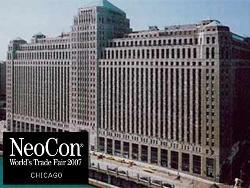NeoCon Releases Trend Forecast Prior to 2024 Event
Chicago, IL, May 30, 2024-The 55th edition of NeoCon will be held June 10 to 12. An estimated 50,000 attendees will convene at The Mart in Chicago to experience firsthand the latest trends and innovations influencing the future of shared spaces. From fostering deeper connections and prioritizing sustainability to learning from neuroscience, NeoCon exhibitors are pioneering what’s next in design with creative solutions for environments that are not only innovative and functional but also enriching and inclusive.
Below are just a few impactful themes shaping today’s workplaces, hotels, restaurants, retail spaces, educational institutions, and healthcare facilities––alongside standout new products and solutions from NeoCon exhibitors that support these movements.
Community & Co-Creation to the Fore
The proverbial “water cooler talk” now takes many different forms, but community and culture are still cultivated through spontaneous encounters and casual in-person interactions. Designing built environments that promote these moments of connection, collaboration, and camaraderie is crucial to nurturing a positive company culture. Gensler’s Design Forecast for 2024 notes that “creating human-centric workplaces that inspire purpose and demonstrate organizational values will help firms stand out to potential talent and clients alike.” To foster this sense of connection, designers are employing subtle social engineering by using spatial arrangements to create collaborative areas that complement private, focused workspaces. Additionally, they are providing more co-creation spaces, where collaborative learning is facilitated through various tools and resources, enabling teams to brainstorm, experiment, and innovate together.
Colors & Emotions: The Rise of Neuroaesthetics
NeoCon exhibitors are blending form and function using the principles of neuroaesthetics, a nascent field exploring how environmental elements like color, sound, and art impact individuals’ brains, emotions, and spatial experiences on a subconscious level. The notion that sights and sounds impact one’s mood is not novel, but neuroaesthetics takes things a step further, harnessing these elements to promote well-being, productivity and enrichment. “Neuroscience-informed design shows us that science can guide us to good choices,” comments Sally Augustin, PhD Fellow, American Psychological Association & principal, Design With Science. Multiple studies have found that beautiful and functional design is at the root of people’s happiness in the workplace.
Inclusive Innovation: Designing for Equity & Wellbeing
There is no such thing as a universal response to a space. Everyone has their own unique reaction to their environment due to many factors including, but not limited to age, wellness, race, sexuality, and overall personal experience. Research suggests that 15% to 20% of the world's population is neurodivergent, meaning their brains process information differently than what is considered “typical.” Accounting for neurodiversity and designing workplaces that cater to and celebrate difference has shifted from being a preference to an expectation. Designers are increasingly charged with creating wellness-inducing spaces and specifying products that are welcoming and beneficial to all. When designing with a human-centered lens, everything that engages the senses––from texture, sound, layout, and color, to the shape and function of the furniture––comes into play. Kay Sargent, Director of Workplace at HOK, notes, “When we design for neurodiversity, we create space that enables all individuals, neurotypicals included, to find suitable levels of privacy and concentration, connection and engagement.”
Sustainability: A Non-Negotiable
With the built environment responsible for approximately 42% of annual global CO2 emissions, sustainable design practices have shifted from being a trend to an essential expectation. The use of eco-friendly, circular materials and solutions in the built environment is the norm and companies are opting for materials that have a lower environmental impact, such as recycled plastics, reclaimed wood, and biodegradable composites. Production transparency to consumers continues to be a significant demand and more forward-thinking firms and furniture brands alike are putting their sustainability credentials on display––demonstrating their commitments to environmental stewardship by reducing their carbon and physical footprints, decarbonizing their supply chain, and pursuing LEED, BREEAM, and other certifications and standards.
